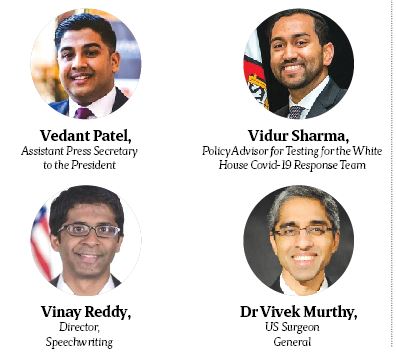 First of all, Kamala Harris (56) represents the march of history as a woman of Indian descent. Harris has broken the glass ceiling and assumed the office of US Vice-President, an office that had been the mainstay of male politicians so far. She is sure to bring to her history-making role at the White House an array of skills that Biden will rely on. Harris is also the first female, first Black and first South Asian American vice president. She has credited her Indian mother for showing faith in her and always reminding her two daughters that “though we may be the first, we should not be the last.”
First of all, Kamala Harris (56) represents the march of history as a woman of Indian descent. Harris has broken the glass ceiling and assumed the office of US Vice-President, an office that had been the mainstay of male politicians so far. She is sure to bring to her history-making role at the White House an array of skills that Biden will rely on. Harris is also the first female, first Black and first South Asian American vice president. She has credited her Indian mother for showing faith in her and always reminding her two daughters that “though we may be the first, we should not be the last.”
Harris remembered her late mother Shyamala Gopalan, a cancer researcher and civil rights activist from India, saying she has always carried that lesson from her mother with her throughout her career from serving as the first woman District Attorney of San Francisco to the first woman Attorney General of California, and the first woman of colour to represent California in the United States Senate.
“My story is the story of millions of Americans. My mother Shyamala Gopalan arrived in the United States from India. She raised my sister Maya and me to know that though we may be the first, we should not be the last,” Harris said at the Presidential Inaugural Committee’s official Asian American inaugural ball, hosted virtually by IMPACT, the leading Indian American advocacy and political action committee on Wednesday. “Your continued faith in me has brought me to this moment,” she said.
She said when she accepted the nomination to be the Vice President, she did so fully committed to realising the vision of a stronger, more united America that provides an opportunity for all, a vision shared by President Joe Biden and one they will “strive to fulfill”. She said both of them know that there is nothing that cannot be accomplished if done together. “We are committed to working with you in the days and months ahead to rebuild our nation in a way that lifts up all Americans,” she said.
Before becoming Biden’s running mate, Harris had her own presidential dreams, which she abandoned due to lack of the financial resources to continue her campaign. She’s one of the only three Asian Americans in the Senate and she’s the first Indian-American ever to serve in the upper chamber. During the Obama era, she was popularly called the “female Obama”.
Harris has been married to Douglas Emhoff, a lawyer, for the past six years. She is the stepmother of two children, Ella and Cole who are her “endless source of love and pure joy.” Just before Harris was sworn in as US vice president, she posted a moving video on her Twitter as a tribute to the women “who came before her” and her mother who moved to the US from India to pursue the big American dream. “I’m here today because of the women who came before me. And to the woman most responsible for my presence here today — my mother, Shyamala Gopalan Harris, who is always in our hearts,” Harris said.
“When she came here from India at the age of 19, maybe she didn’t quite imagine this moment. But she believed so deeply in an America where a moment like this is possible. So, I’m thinking about her and about the generations of women — Black women. Asian, White, Latina, and Native American women throughout our nation’s history who have paved the way for this moment tonight,” she said.
“Women who fought and sacrificed so much for equality, liberty, and justice for all, including the Black women, who are too often overlooked, but so often prove that they are the backbone of our democracy,” she said.
In an act of honour, Kamala Harris took the oath of the Vice-President’s office with her hand on two Bibles. This was no mere coincidence either. One of the bibles belonged to the first Supreme Court justice of African-American lineage, Thurgood Marshall, who was also a civil rights icon.
Highlighting the significance of family and friends, the second bible belonged to Harris’ neighbour and a motherly influence in her life, Regina Shelton. The act signified the humane touch Harris would bring to an office that had seen a rough past four years marked with many allegations of human rights violations and racial discrimination.
Indian Americans





 Coming to Indian Americans, US President has either nominated or named at least 20 Indian Americans, including 13 women, to key positions in his administration, a new record in itself for this small ethnic community that constitutes one per cent of the country’s population. As many as 17 of them would be part of the powerful White House complex. The dedication that the Indian-American community has shown to public service over the years has been recognized in a big way at the very start of this administration! I am particularly pleased that the overwhelming majority are women. We take from a digital platform for positive news, TheBetterIndia pictures and brief profiles of these 20 persons.
Coming to Indian Americans, US President has either nominated or named at least 20 Indian Americans, including 13 women, to key positions in his administration, a new record in itself for this small ethnic community that constitutes one per cent of the country’s population. As many as 17 of them would be part of the powerful White House complex. The dedication that the Indian-American community has shown to public service over the years has been recognized in a big way at the very start of this administration! I am particularly pleased that the overwhelming majority are women. We take from a digital platform for positive news, TheBetterIndia pictures and brief profiles of these 20 persons.
Topping the list is Neera Tanden, who has been nominated as Director of the White House Office of Management and Budget and Dr Vivek Murthy, who has been nominated as the US Surgeon General.
Vanita Gupta has been nominated as Associate Attorney General Department of Justice, and on Saturday, Biden nominated a former foreign service official Uzra Zeya as the Under Secretary of State for Civilian Security, Democracy, and Human Rights.
Mala Adiga has been appointed as Policy Director to the future First Lady Dr Jill Biden and Garima Verma would be the Digital Director of the Office of the First Lady, while Sabrina Singh has been named as her Deputy Press Secretary.
For the first time ever among the Indian-Americans include two who trace their roots to Kashmir: Aisha Shah, who has been named as Partnership Manager at the White House Office of Digital Strategy, and Sameera Fazili, who would occupy the key position of Deputy Director at the US National Economic Council (NEC) in the White House.
White House National Economic Council also has another Indian American, Bharat Ramamurti, as Deputy Director.
Gautam Raghavan, who served at the White House in the previous Obama Administration returns to the White House as Deputy Director in Office of Presidential Personnel.
Among Biden’s inner circle is his top confident for year Vinay Reddy, who has been named as Director Speechwriting.
Young Vedant Patel all set to occupy a seat in the White House lower press, behind the briefing room, as Assistant Press Secretary to the President. He is only the third-ever Indian American to be part of the White House press shop.
Three Indian-Americans have made their way to the crucial National Security Council of the White House, thus leaving a permanent imprint on the country’s foreign policy and national security.
They are Tarun Chhabra: Senior Director for Technology and National Security, Sumona Guha, Senior Director for South Asia, Shanthi Kalathil: Coordinator for Democracy and Human Rights.
Sonia Aggarwal has been named Senior Advisor for Climate Policy and Innovation in the Office of the Domestic Climate Policy at the White House and Vidur Sharma has been appointed as Policy Advisor for Testing for the White House COVID-19 Response Team.
Two Indian Americans women have been appointed to the Office of the White House Counsel: Neha Gupta as Associate Counsel and Reema Shah as Deputy Associate Counsel.
Also, for the first time in any administration, the White House would have three other South Asians in key positions.
Pakistani-American Ali Zaidi as Deputy National Climate Advisor White House; Sri Lankan American Rohini Kosoglu as Domestic Policy Advisor to the Vice President and Bangladeshi-American Zayn Siddique: Senior Advisor to the White House Deputy Chief of Staff.
During the campaign, Biden had indicated that he would rope in a large number of Indian Americans.
“As President, I’ll also continue to rely on Indian-American diaspora, that keeps our two nations together, as I have throughout my career,” Biden had said in his address to the Indian-American community during a virtual celebration of India’s Independence Day on August 15, 2020. “My constituents in Delaware, my staff in the Senate, the Obama Biden administration, which had more Indian Americans than any other administration in the history of this country and this campaign with Indian Americans at senior levels, which of course includes the top of the heap, our dear friend (Kamala Harris) who will be the first Indian American vice president in the history of the United States of America,” Biden said
in his video address.
Power of Purple
It was a day of firsts besotted with symbolism that encapsulated the struggles of millions. Purple has been associated with wealth, passion, power, royalty, luxury, ambition, magic, religion and extravagance since the beginning of civilization, perhaps in part because of its relative rarity in nature but also its essential innate beauty. It was purple all the way at the ceremony. Power dressing with a string of pearls… a formal dress in purple with a matching coat, the very first woman to be the American Vice President, Kamala Harris, set a strong statement through her sartorial choices for the historic swearing-in ceremony at the Capitol Hill.
To say that it was a historic moment would be an understatement and the symbolism at display truly summed up the dreams and aspirations of many generations of proud Americans who have painstakingly worked to get to this point. The colour purple is seen as Harris’ acknowledgement to women suffrage, something that she acknowledged in her tweet as well, ‘I’m here today because of the women who came before me’. In the US, purple is traditionally seen as a colour of bipartisanship, a mix of red and blue, colours of the Republican and Democratic parties. Harris’ choice in colour was deliberate, many see it as a tribute to Shirley Chisholm, the first Black woman elected to the Congress. She accessorised her attire with her favourite — pearls — for the special swearing-in by Wilfredo Rosado and an American flag lapel pin by David Yurman. Looks like those who hoped to see the Madame Vice President in a saree or a creation by Prabal Gurung acknowledging her South-Asian roots have to wait for her acknowledgement of Indian roots. While President Joe Biden and Second Gentleman Douglas Emhoff took to Ralph Lauren suits, navy blue and grey, respectively; First Lady Dr Jill Biden stunned in Alexandra O’Neill’s ocean blue ensemble adorned with Swarovski pearls and crystals.
An emotional Lady Gaga performed a dramatic version of the US national anthem, Garth Brooks sang a cappella, and Tom Hanks hosted a star-studded celebration to cap President Joe Biden’s inauguration on Wednesday. On a day marked by diversity and appeals for unity, Gaga wowed in a fuchsia Schiaparelli couture silk skirt and black top adorned by a large gold brooch of a dove carrying an olive branch as she sang The Star-Spangled Banner at the ceremony. Gaga at one point gestured to the US flag flying high over the Capitol. Jennifer Lopez, dressed in white pants and a long matching coat, performed a medley of This Land is Your Land and America The Beautiful, interjecting in Spanish the part of the US Pledge of Allegiance that says, “One nation, under God, indivisible, with liberty and justice for all.”
Poet Amanda Gorman captured the mixed emotions of the past four years with a poem in which she called herself a “skinny Black girl, descended from slaves and raised by a single mother (who) can dream of becoming president only to find herself reciting for one.” The cultural celebrations continued with a broadcast across television and social media, hosted by Tom Hanks. The events, bringing together some of the biggest white, Black and Hispanic celebrities, marked a sharp contrast with Trump’s inauguration in 2017, which was low on star power.
Kamala Harris wore a purple dress created by Christopher John Rogers and Sergio Hudson, two black designers. President Joe Biden’s outfit was also designed by an American but Harris made a bigger statement that said that it was about time that designers of African-American origin were here on the big stage. The colour purple is also linked with American bipartisanship as it is made with the combination of red and blue — the colours of the Republican and Democratic parties respectively. This signifies unity in an administration that has inherited an extremely polarised USA.
However, some quipped if the colour was an ode to her Indian heritage and culture as well. Women aren’t afraid to wear bright, bold hues in India unlike the West, where they have been dubbed as being ‘loud’ by the patriarchy.
Purple is also intrinsically weaved into the women’s suffrage movement. It was a decades-long battle for the right for women to vote in the US. Purple is also linked to the story of Shirley Chisholm, the first black woman to run for the office of US President. Chisholm was also the first black woman elected to the US Congress and she was well known for using purple in her campaign flyers.
Harris also wore a pearl necklace. It was seen as an acknowledgement to her sorority, Alpha Kappa Alpha, the first intercollegiate historically African American Greek-lettered sorority. The pearls are also associated with the black sisterhood that has helped her stand strong against all-white male bastions throughout her life.
However, Kamala Harris was not alone in wearing purple on the historic day. She was joined by thousands of women wearing pearls or the colour purple around the US. Nearer to her at the inauguration, Senator Elizabeth Warren was also seen in purple.
Purple was the colour of choice for Hillary Clinton too; she had also worn purple in 2016 while conceding the elections to Donald Trump. She was joined in purple hues by Michelle Obama and notably, US First Lady Jill Biden also wore purple for Tuesday night’s vigil at the Lincoln Memorial Reflecting Pool. Joe Biden has often referred to the US as a ‘purple nation’ and it is this theme of unity that will help the Trump-marred democracy especially after years of discord, unrest and violence.
Kamala Harris has embarked on a journey of firsts, and may the power of purple stay with her during the tumultuous times of pandemic and its aftermath.
letters@tehelka.com












